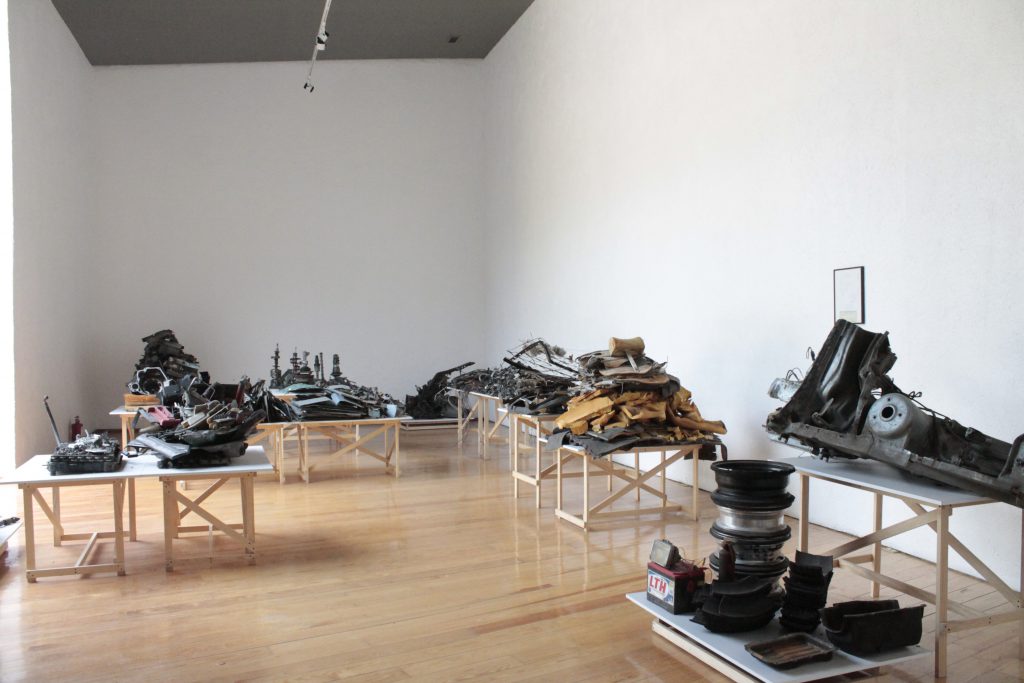Crushed Autogeddon// El esqueleto mineral que nos permitirá aventajar a la evolución (The Mineral Skeleton That Will Allow Us Evolution)
Folke Köbberling // Arturo Hernández Alcázar
March 18 – May 21, 2017
Curator: Paola Santoscoy
Within the framework of Mexibility El Eco proposed a collaboration between German artist Folke Köbberling (Germany, 1969) and Mexican artist Arturo Hernández Alcázar (Mexico, 1978) on the themes of mobility and ecology. The collaboration unfolded under the terms dictated by the process of exploration itself and in relation to the work context and discussions derived from it between those involved. This resulted in two different works that coexist, overlap, and, to a certain extent, confront each other within the museum space.

The starting point, apart from the invitation to create a site-specific intervention in El Eco, was the complex political, historical, and economic equation of the global auto industry and the different ways it has an impact at the local level. Considered strictly in terms of trade relations between Mexico and Germany, it is well known that, since the 1960s, there have been some large automobile manufacturing plants in Mexico. As a result, our first conversations touched on the subject of the famous Volkswagen emissions scandal and on that of the no less pollution reduction program in Hoy No Circula famous Mexico City, but centered primarily on mobility as a need that has catalyzed large-scale urbanization projects in the Valley of Mexico. From these discussion there emerged a series of possible critical operations, gestures, and actions suggested by both artists.

Köbberling’s contribution Crushed Autogeddon (2017), is an indictment of consumerist ideologies on the basis of alternatives that have been present in his work for several years. One of her emblematic pieces in collaboration with Martin Kaltwasser (Germany, 1965), Cars into Bicycles (2008-2010), consisted of transforming, over a period of three months, an automobile into functional bicycles. The work produced for El Eco consisted of purchasing a used car, still in working order, and putting it in the park across from the museum, where it was dismantled by the artist herself and some assistants, who also invited passersby to take part in the gradual and irremediable dismemberment of this icon of advanced technology. On this occasion, the disassembled pieces were brought into the museum one by one to be destroyed there by hand and reclassified in accordance with their original material and origin. In doing this, Köbberling created a sober sculpture, produced by physical effort and capable of containing a map of globalized commercial and political relations.
Hernández Alcázar’s contribution, on the other hand, involved setting up a melting furnace -specifically for aluminum- in the patio of the museum. The intervention El esqueleto mineral que nos permitirá aventejar a al evolución is entitled (The Mineral Skeleton That Will Allow Us Evolution [2017]) Le piéton to Surpass , after Alfred Jarry’s In this brief text, the French poet and playwright, écraseur. considered a precursor of Dadaism and surrealism and (1896), warns of the Ubu roi known for his political satire enormous danger posed by pedestrians to automobiles and bicycles alike. Jarry’s poetic operation in the aforementioned text serves as a transition to another kind of transformation, which consists of finding spare aluminum auto parts mainly of German manufacture in junkyards and on the informal market, so that they can be melted down. It might be said that aluminum is synonymous with technology progress in the automobile industry, owing to its physical and chemical properties. Nowadays it is used to manufacture all manner of pumps, spare parts, cylinder heads and blocks, rims, radiators, and transaxles, as well as many of the panels that make up the chasses of certain cars. The liquid aluminum will be poured onto a bed of sand in the patio of the museum, so that within a few seconds it will take on a very different shape from its original one, resulting in sculptures that create an alteration in the usual circulation of goods and power. There is a divergence in the work of these two artists in their ways of understanding participation and intervention.

While the work of Hernández Alcázar proposes a smelting process performed in a furnace constructed inside the museum, which required the participation of other people skilled in the activity of pouring the liquid aluminum onto the floor of the museum, Köbberling’s work proposes a collective process in which volunteers or even passersby may potentially participate actively in the piece. Both works take different risks with regard to these questions. Nevertheless, they both impose a certain violence on the materials that turn into powerful sculptural gestures, capable of shaking, both literally and metaphorically, the structures.
*MEXIBILITY project. At the heart of this wide ranging undertaking is the theme of mobility, which, along with the purely physical forms of movement in the city, also addresses questions of social, economic, and ecological mobility.